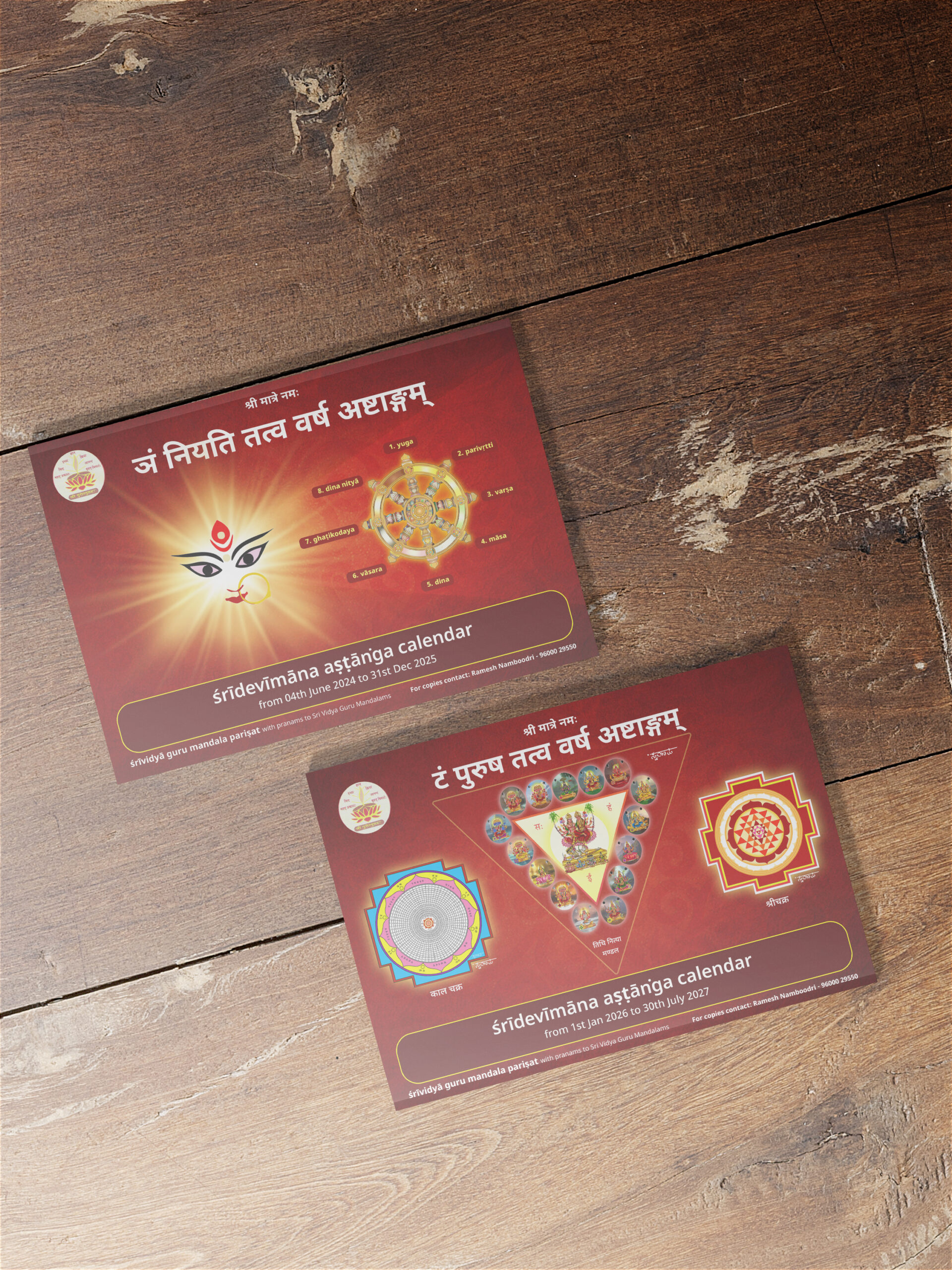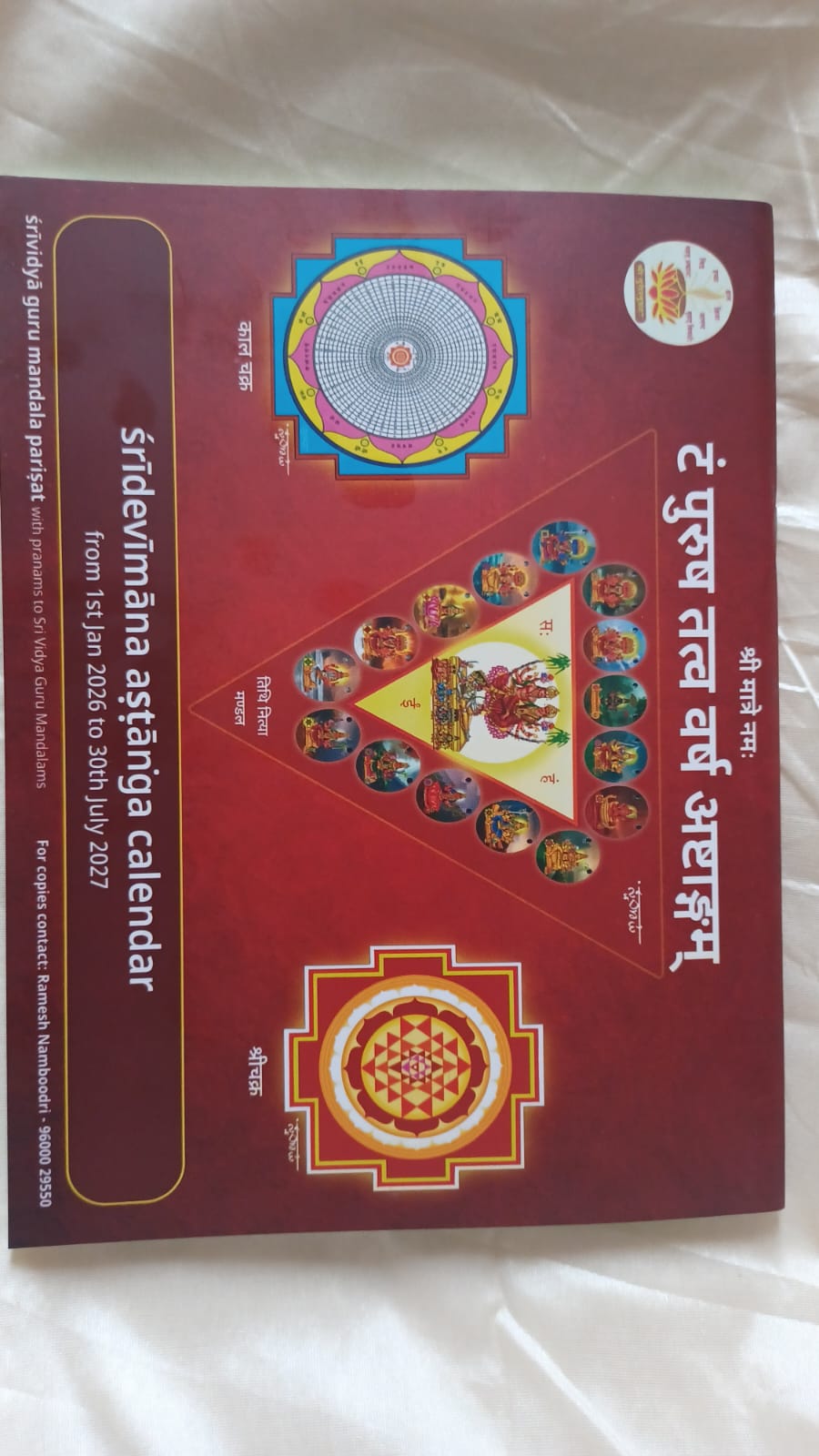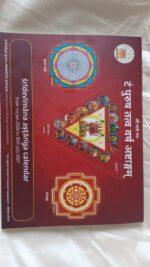What is astanga?
Śrī vidyā sādhakas use a calendar called aṣtāṅga based on Śrī vidyā tattvas. At the very beginning, from dimensionless Bindu this Universe evolved, due to a movement (spanda) in that bindu. Time and space got evolved almost together. Hence, Time and Space are interrelated and one cannot exist without the other (avinābhāva sambanda). The subtle element time always co-exists with physical space. The subtle element space has its aspect as ‘sound’, from which all alphabets evolved (Mātṛkā akṣarā). The tattvas for this visible universe are thirty-six according to traipura siddhānta and are represented by these Mātṛkā akṣarā. Space is defined as existence between two intervals of time, thus this aṣtāṅga focuses on time only.
What are the eight limbs- aṣtāṅga?
Eight (aṣta aṅga) limbs are yuga, parivṛtti, varṣa, māsa, dina, vāsara, ghaṭikodaya, dina nityā.
What is the initial day of this astanga?
The initial day is taken as kali yuga’s first day
Explain each limb.
One week has nine days (Vāsara) – they are named after navanātha:-prakāśa, vimarśa, ānanda, Śrīgyāna, Śrīsatya, Śrīpūrṇa, svabhāva, pratibha and subhaga.
–eg. Vimarśānandanātha vāsara
There are four weeks in a month (māsa), so from the above logic, there are thirty-six days (dina) in a month. These days are named after thirty-six tattvas, with Mātṛkā akṣarās which are vowel ‘a’ with thirty five consonants. am śiva tattva, kam śakti, kham sadāśiva, gam īśvara, gham śuddha vidyā, Ṅgam māya, cam kalā, cham avidyā, jam rāga, jham kāla, njam niyati, Tam puruṣa, Tham prakṛti, Dam ahamkāra, Dham bhuddhi, ṇam maṇa, tam śrotra, tham tvak, dam cakṣus, dham jihvā, nam ghrāṇa, pam vāk, pham pāṇi, bam pāda, bham pāyu, mam upastha, yam śabda, ram sparśa, lam rūpa, vam rasa, śam gandha, ṣam ākāśa, sam vāyu, ham vahni, Lam jala and kṣam pṛthvi.
-eg. Kham sadāśiva tattva dina
There are sixteen months (called māsa) in a year named after the nityās or soma mandala kalā or sadāśiva kalā. Hence, we can find five hundred and seventy-six days in a year
.-eg. Om sarvamaṅgalā nityā / prīti kalā / gyānāmṛtā kalā māsa
There are thirty-six years (called varṣa) named after the thirty-six tattvas, already said above. eg jam rāga tattva varṣa
A cycle of thirty-six years is called a parivṛtti, which are also named after the thirty six tattvas which will have 576 months and 20736 days. (Roughly 57 and odd years)
-eg pam vāk tattva parivṛtti
A cycle of thirty-six parivṛtti is called a yuga, also named as above
-eg. Kham sadāśiva tattva yuga.
Another aṅga is called ghaṭikā. A time interval of twenty-four minutes is called a ghaṭikā. Thus, there are sixty ghaṭikās in a day. Each ghaṭikā is assigned with Mātṛkā akṣara. The visarga (ah) is left out in the vowels. Thus, fifteen vowels and thirty-five consonants are taken in order for naming ghaṭikā. Only fifty ghaṭikās will be named thus, the rest ten are repeated from the first ghaṭikā. Thus, on day one, we start with ‘a’ as udaya ghaṭikā akṣara then as per the above guidelines we will end up in the ‘LRR’ ghaṭikā, next day udaya ghaṭikā will be ‘e’. Similar calculations will result in third day udaya ghaṭikā as ‘ca’, fourth day as ‘ta’ and fifth day as ‘ya’, sixth day will be again ‘a’ and the cycle will repeat . So, we have only five udaya ghaṭikā – akāra, ekāra, cakāra, takāra and yakāra.
One more aṅga is called dina nityā. They are the fifteen nityās in the same order for śukla pakṣa and the same in reverse for the kṛṣṇa pakṣa, similar to the tithi nityās. The only difference is that it is not dependent on the lunar calendar, one per day in the said order. Thus we find thirty in a cycle, eg:- em śukla nīlapatākā dina nityā, or im kṛṣṇa nityaklinnā dina nityā.
What are the uses of this aṣtāṅga?
With the help of this aṣtāṅga nitya and naimittika pujas are done and also there are four pārāyaṇās (nātha pārāyaṇa, ghaṭikā pārāyaṇa, tattva pārāyaṇā and nityā pārāyaṇa). There is a unique mantra called the dina nityā vidya to be chanted along with each pārāyaṇā
How to do sankalpa in puja?
For daily pūja:
ādi guroḥ paraśivasyāgyanayā pravartamāna devī mānena ṣat trimśat tattvātmaka sakala prapanca sṛṣṭi sthiti samhāra tirodhāna anugraha kāriṇyāh parāśaktyāh Ūrdhva bhrū vibrame kham sadāśiva tattva yuge dam cakṣuḥ tattva parivṛttau ___ varṣe___ nityā/kalā māse ___ tattva dine___nātha vāsare __ghaṭikodaye __ dina nityāyām __ tithi nityāyām Sri Mahā trpurasundarī prīthyartham yathā sambhavaddravaih yathā śakti saparyā kramam nirvartayiṣye tena parameśvaram prīṇayāmi.
How to do sankalpa in parayana?
For daily pārāyaṇa:
ādi guroḥ paraśivasyāgyanayā pravartamāna devī mānena ṣat trimśat tattvātmaka sakala prapanca sṛṣṭi sthiti samhāra tirodhāna anugraha kāriṇyāh parāśaktyāh Ūrdhva bhrū vibrame ___nātha vāsare __ghaṭikodaye ___ tattva varṣe___ nityā/kalā māse kham sadāśiva tattva yuge dam cakṣuḥ tattva parivṛttau Sri Mahā trpurasundarī prīthyartham ___ pārāyaṇamaham kariṣye.
How to find the dina nitya mantra?
This syllable as per Paramānanda tantra will have eight syllables. The astanga dini nitya mantra is said to have four bindus. The construction will be vāsaranātha akṣara+ghatokodaya akṣara+bindu is first, dina akṣara+ dina nitya akṣara+ bindu will be second, varṣa akṣara+ māsa akṣara+ bindu will be third and yuga akṣara+ parivṛtti akṣara+ bindu will be fourth.
For example: Consider above example- kham sadāśiva tattva yuga- dam cakṣus tattva parivṛtti- gam īśvara tattva varṣa- ḹm Nityā nityā (OR ḹm Kānti kalā māsa)- gham śuddha vidyā tattva dina- ṭam ŚrīSatyānandanātha vāsara- ‘E’ kāra ghaṭika- aum kṛṣṇa jvālāmālini dina nityā.
The astaṅga- dina nityā vidyā will be as follows: ‘3- (pancadasi) ka15- ṭa-Em gha-aum ga-ḹm kha-dam’
Tomorrow it will be “‘3- (pancadasi) ka15-ta-cam nga-am ga-ḹm kha-dam”, only the first four will change in a month, the last will change only in a parivrtti.
It is interesting to note that just by knowing this aṣtāṅga syllable we can chant all pārāyaṇās in order from nātha to nityā.
There is repentance (prayascitta) said in the Paramānanda tantra for non-observance of pārāyaṇa, due to unforeseen circumstances, as nine time mūla mantra japa for nātha, sixty for ghaṭikā, thirty six for tattva and thirty for nityāpārāyaṇa.
Another form of dina nityā vidyā is seen in tantra rāja tantra. It is varṣākṣarā +māsākṣarā, dinākṣarā+ā+ī+hamsah.
From above example we can now derive dina nityā vidyā as “ga+ ḹm+ gha+ ā+ ī+ hamsah”, which will be “‘3- (pancadasi) ka15-gḹ-ghā-ī-hamsah”’. We have fixed three parameters the rest will fall in line, since this is a totally mathematical equation.
What are the special paravas in astanga? There are six special parvā (special days) in this calendar. They are called puṣpiṇi, mohini, jayini, kumāri, vimalā and ŚrīkarI in this aṣtāṅga calendar. The conjunction (same syllable occurring) of varṣākṣara with masākṣara will be first, with dinākṣara will be second, and with udayaghaṭikā will be third respectively. Conjunction of māsākṣara with dinākṣarā will be fourth; with udayaghaṭikā will be fifth. Similarly dinākṣarā and udyaghaṭikākṣarā will last conjunction respectively.
How frequently will these special paravas occur?
The first- puṣpiṇi- is possible once in a parivṛtti, while it is starting, in ‘am’ śiva tattva year, this is possible for that whole month, which will be ‘am’ kāmeśvari nityā māsa, for 36 days. (Once in roughly 57 odd years)
The second-mohini- will be there once a month, with sixteen in a year. Since year and dina akṣaras are same this is sure to happen once in a month. For eg, in kham sadaśiva tattva varṣa, the third day of any month, kham sadaśiva tattva dina will be this parva, in all sixteen months.
The third-jayini- is possible in am śivatattva, cam kalātattva, tam śrotra tattva, yam śabda tattva years in a parivṛtti, with the akāra, cakāra, takāra and yakāra ghaṭikodaya respectively.
The fourth-kumāri- is the first day of every year, where we find am kāmeśvari māsa and am śiva tattva dina, hence this will be in prakāśānandanātha vāsara.
The fifth-vimalā- will be in the first (am) and eleventh (Em) month every year, with the ‘a’kāra and ‘E’kāra ghaṭikodayās respectively. .
The sixth-Śrīkari- will be there in once in a month, in the ‘a’, ‘ca’, ‘ta’, ‘ya’ dinas in four successive months respectively on ‘a’kāra, ‘ca’kāra, ‘ta’kāra and ‘ya’kāra ghaṭikodaya and then will skip a month.
What to do on these special parava?
On these days special pūjas can be done, esp. the guru mandala pūja said in Tantra rāja tantra.
Let us now start to practice this aṣtāṅga calendar for our daily use with this knowledge which is an outcome of Sri Guru’s grace.

























Reviews
There are no reviews yet.